Power Ltd: Financial Accounting and Reporting on Consolidation
VerifiedAdded on 2023/03/21
|6
|1135
|37
Report
AI Summary
This report provides a detailed analysis of financial accounting and reporting issues related to the consolidation of financial statements, specifically addressing business acquisitions and their impact on accounting practices. It covers key issues such as the consolidation of assets and liabilities, ...
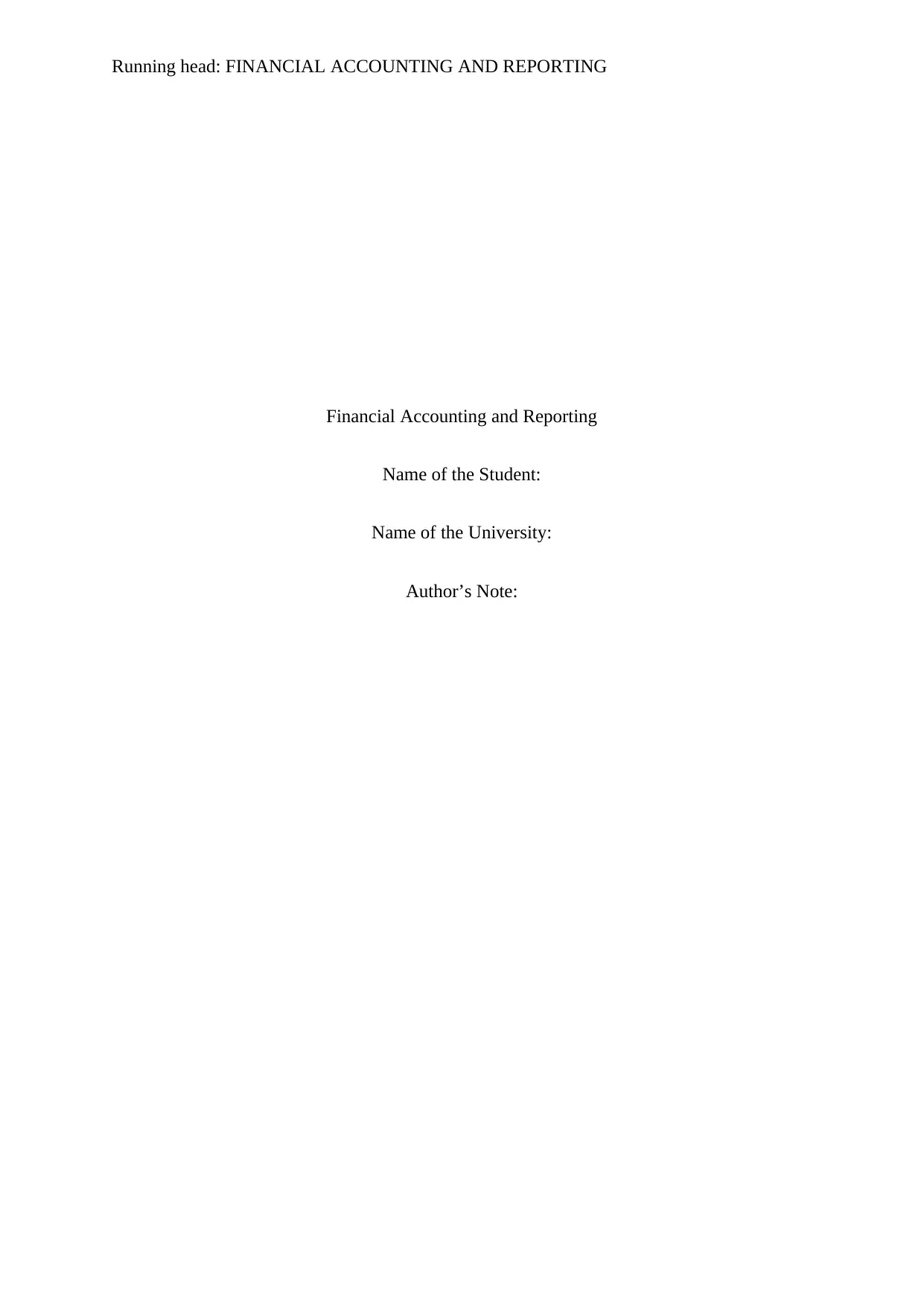
Running head: FINANCIAL ACCOUNTING AND REPORTING
Financial Accounting and Reporting
Name of the Student:
Name of the University:
Author’s Note:
Financial Accounting and Reporting
Name of the Student:
Name of the University:
Author’s Note:
Paraphrase This Document
Need a fresh take? Get an instant paraphrase of this document with our AI Paraphraser
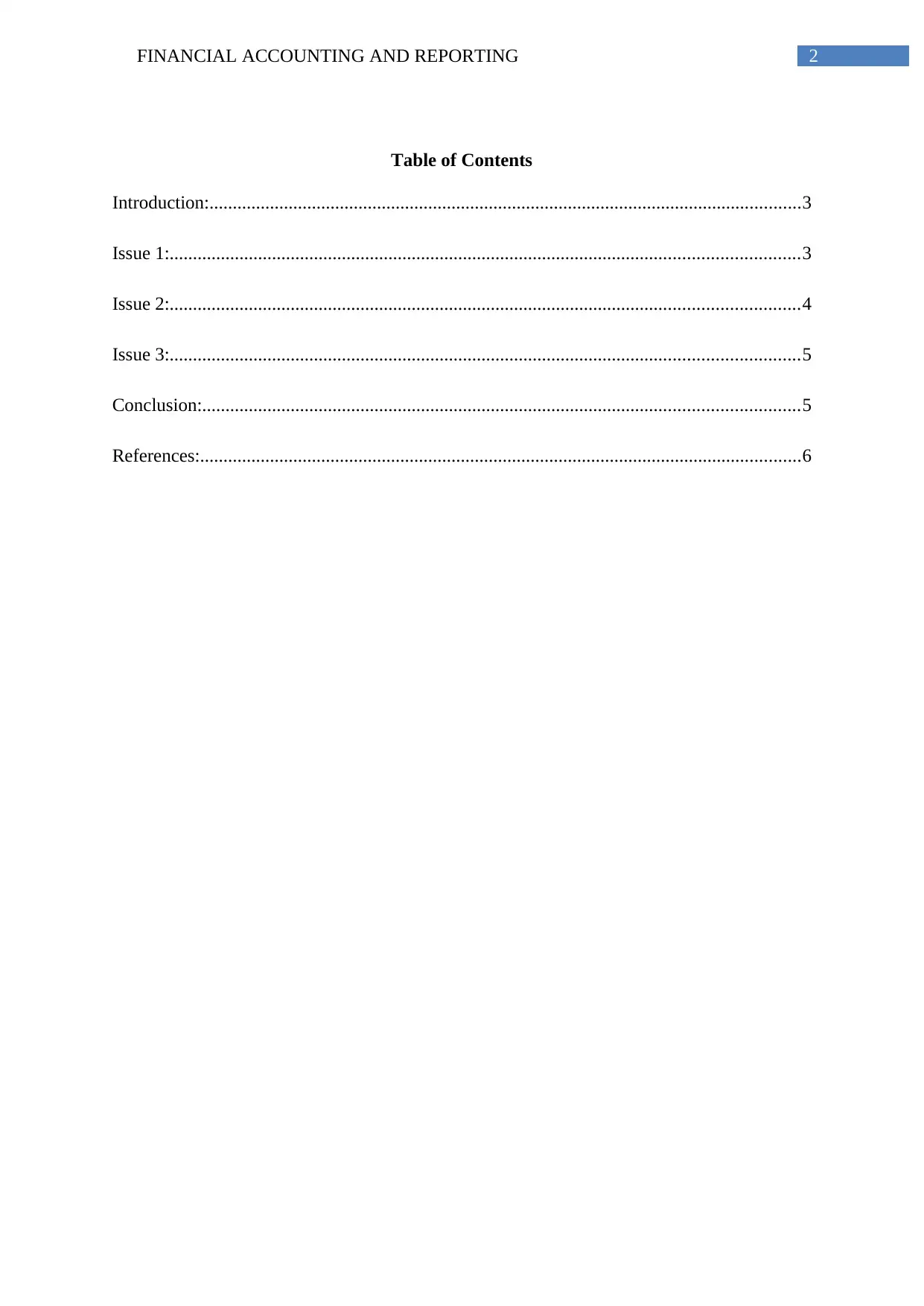
2FINANCIAL ACCOUNTING AND REPORTING
Table of Contents
Introduction:...............................................................................................................................3
Issue 1:.......................................................................................................................................3
Issue 2:.......................................................................................................................................4
Issue 3:.......................................................................................................................................5
Conclusion:................................................................................................................................5
References:.................................................................................................................................6
Table of Contents
Introduction:...............................................................................................................................3
Issue 1:.......................................................................................................................................3
Issue 2:.......................................................................................................................................4
Issue 3:.......................................................................................................................................5
Conclusion:................................................................................................................................5
References:.................................................................................................................................6
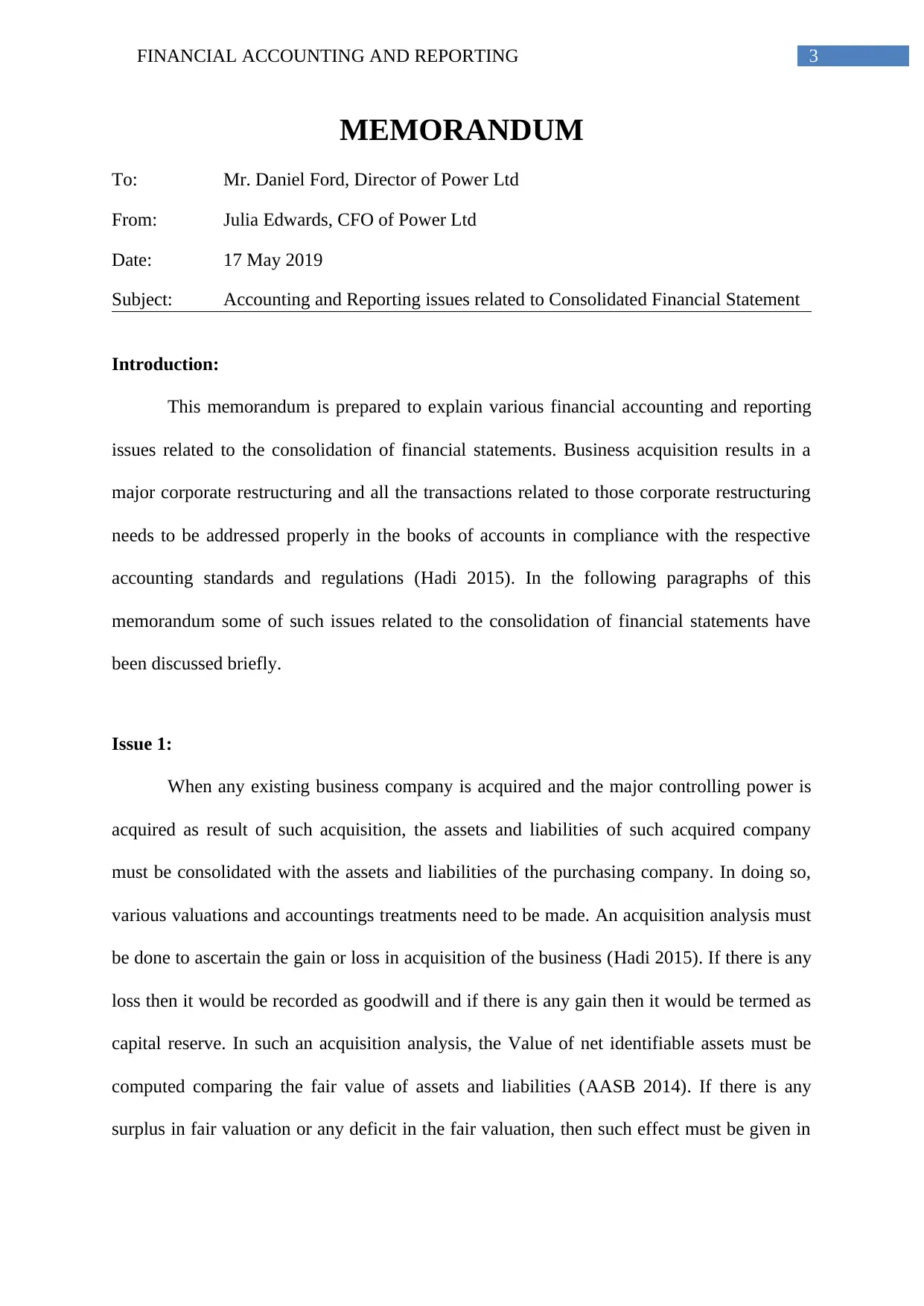
3FINANCIAL ACCOUNTING AND REPORTING
MEMORANDUM
To: Mr. Daniel Ford, Director of Power Ltd
From: Julia Edwards, CFO of Power Ltd
Date: 17 May 2019
Subject: Accounting and Reporting issues related to Consolidated Financial Statement
Introduction:
This memorandum is prepared to explain various financial accounting and reporting
issues related to the consolidation of financial statements. Business acquisition results in a
major corporate restructuring and all the transactions related to those corporate restructuring
needs to be addressed properly in the books of accounts in compliance with the respective
accounting standards and regulations (Hadi 2015). In the following paragraphs of this
memorandum some of such issues related to the consolidation of financial statements have
been discussed briefly.
Issue 1:
When any existing business company is acquired and the major controlling power is
acquired as result of such acquisition, the assets and liabilities of such acquired company
must be consolidated with the assets and liabilities of the purchasing company. In doing so,
various valuations and accountings treatments need to be made. An acquisition analysis must
be done to ascertain the gain or loss in acquisition of the business (Hadi 2015). If there is any
loss then it would be recorded as goodwill and if there is any gain then it would be termed as
capital reserve. In such an acquisition analysis, the Value of net identifiable assets must be
computed comparing the fair value of assets and liabilities (AASB 2014). If there is any
surplus in fair valuation or any deficit in the fair valuation, then such effect must be given in
MEMORANDUM
To: Mr. Daniel Ford, Director of Power Ltd
From: Julia Edwards, CFO of Power Ltd
Date: 17 May 2019
Subject: Accounting and Reporting issues related to Consolidated Financial Statement
Introduction:
This memorandum is prepared to explain various financial accounting and reporting
issues related to the consolidation of financial statements. Business acquisition results in a
major corporate restructuring and all the transactions related to those corporate restructuring
needs to be addressed properly in the books of accounts in compliance with the respective
accounting standards and regulations (Hadi 2015). In the following paragraphs of this
memorandum some of such issues related to the consolidation of financial statements have
been discussed briefly.
Issue 1:
When any existing business company is acquired and the major controlling power is
acquired as result of such acquisition, the assets and liabilities of such acquired company
must be consolidated with the assets and liabilities of the purchasing company. In doing so,
various valuations and accountings treatments need to be made. An acquisition analysis must
be done to ascertain the gain or loss in acquisition of the business (Hadi 2015). If there is any
loss then it would be recorded as goodwill and if there is any gain then it would be termed as
capital reserve. In such an acquisition analysis, the Value of net identifiable assets must be
computed comparing the fair value of assets and liabilities (AASB 2014). If there is any
surplus in fair valuation or any deficit in the fair valuation, then such effect must be given in
You're viewing a preview
Unlock full access by subscribing today!
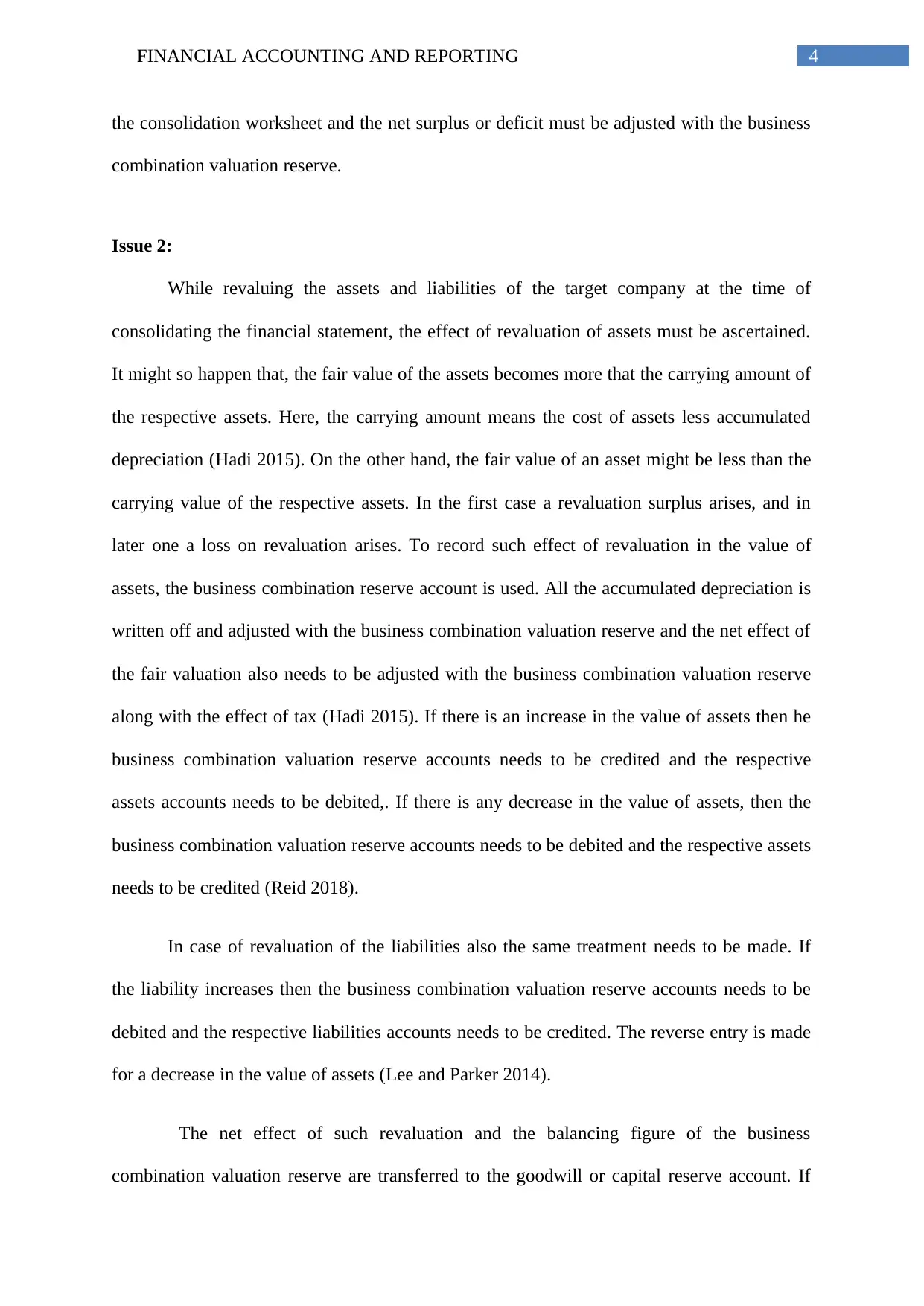
4FINANCIAL ACCOUNTING AND REPORTING
the consolidation worksheet and the net surplus or deficit must be adjusted with the business
combination valuation reserve.
Issue 2:
While revaluing the assets and liabilities of the target company at the time of
consolidating the financial statement, the effect of revaluation of assets must be ascertained.
It might so happen that, the fair value of the assets becomes more that the carrying amount of
the respective assets. Here, the carrying amount means the cost of assets less accumulated
depreciation (Hadi 2015). On the other hand, the fair value of an asset might be less than the
carrying value of the respective assets. In the first case a revaluation surplus arises, and in
later one a loss on revaluation arises. To record such effect of revaluation in the value of
assets, the business combination reserve account is used. All the accumulated depreciation is
written off and adjusted with the business combination valuation reserve and the net effect of
the fair valuation also needs to be adjusted with the business combination valuation reserve
along with the effect of tax (Hadi 2015). If there is an increase in the value of assets then he
business combination valuation reserve accounts needs to be credited and the respective
assets accounts needs to be debited,. If there is any decrease in the value of assets, then the
business combination valuation reserve accounts needs to be debited and the respective assets
needs to be credited (Reid 2018).
In case of revaluation of the liabilities also the same treatment needs to be made. If
the liability increases then the business combination valuation reserve accounts needs to be
debited and the respective liabilities accounts needs to be credited. The reverse entry is made
for a decrease in the value of assets (Lee and Parker 2014).
The net effect of such revaluation and the balancing figure of the business
combination valuation reserve are transferred to the goodwill or capital reserve account. If
the consolidation worksheet and the net surplus or deficit must be adjusted with the business
combination valuation reserve.
Issue 2:
While revaluing the assets and liabilities of the target company at the time of
consolidating the financial statement, the effect of revaluation of assets must be ascertained.
It might so happen that, the fair value of the assets becomes more that the carrying amount of
the respective assets. Here, the carrying amount means the cost of assets less accumulated
depreciation (Hadi 2015). On the other hand, the fair value of an asset might be less than the
carrying value of the respective assets. In the first case a revaluation surplus arises, and in
later one a loss on revaluation arises. To record such effect of revaluation in the value of
assets, the business combination reserve account is used. All the accumulated depreciation is
written off and adjusted with the business combination valuation reserve and the net effect of
the fair valuation also needs to be adjusted with the business combination valuation reserve
along with the effect of tax (Hadi 2015). If there is an increase in the value of assets then he
business combination valuation reserve accounts needs to be credited and the respective
assets accounts needs to be debited,. If there is any decrease in the value of assets, then the
business combination valuation reserve accounts needs to be debited and the respective assets
needs to be credited (Reid 2018).
In case of revaluation of the liabilities also the same treatment needs to be made. If
the liability increases then the business combination valuation reserve accounts needs to be
debited and the respective liabilities accounts needs to be credited. The reverse entry is made
for a decrease in the value of assets (Lee and Parker 2014).
The net effect of such revaluation and the balancing figure of the business
combination valuation reserve are transferred to the goodwill or capital reserve account. If
Paraphrase This Document
Need a fresh take? Get an instant paraphrase of this document with our AI Paraphraser

5FINANCIAL ACCOUNTING AND REPORTING
there is a credit balance in the business combination valuation reserve account, then it is
transferred to the Capital Reserve account by a debit the business combination valuation
reserve account and a corresponding credit to the Capital Reserve account. If there is a debit
balance in the business combination valuation then it would be transferred to the Goodwill
account by a debit to the Goodwill account and a credit to the business combination valuation
reserve account (Müller 2014).
Issue 3:
Therefore, it can be understood from the above discussion that all the revaluation
treatments for the revaluation of the assets and liabilities of the target company for
consolidation purpose are given in the books of the purchasing company. The ultimate effect
of such revaluation is either reflected in the goodwill account or in the capital reserve account
in the books of the purchasing company. The temporary account, business combination
valuation reserve, no longer exists in the books of accounts after it is closed and transferred to
either goodwill or capital reserve (Kieso, Weygandt and Warfield 2016).
Conclusion:
From the above discussion and analysis, it can be concluded that, consolidating assets
and liabilities of the target company with the assets and liabilities of the acquiring company
must be done with due care and in compliance with the respective accounting standard.
Assets and liabilities must be restated to their fair value in the books of the purchasing
company. Lastly, it can be recommended for the power limited to revalue the assets and
liabilities of the cargo limited to their respective fair value for the consolidation purpose.
there is a credit balance in the business combination valuation reserve account, then it is
transferred to the Capital Reserve account by a debit the business combination valuation
reserve account and a corresponding credit to the Capital Reserve account. If there is a debit
balance in the business combination valuation then it would be transferred to the Goodwill
account by a debit to the Goodwill account and a credit to the business combination valuation
reserve account (Müller 2014).
Issue 3:
Therefore, it can be understood from the above discussion that all the revaluation
treatments for the revaluation of the assets and liabilities of the target company for
consolidation purpose are given in the books of the purchasing company. The ultimate effect
of such revaluation is either reflected in the goodwill account or in the capital reserve account
in the books of the purchasing company. The temporary account, business combination
valuation reserve, no longer exists in the books of accounts after it is closed and transferred to
either goodwill or capital reserve (Kieso, Weygandt and Warfield 2016).
Conclusion:
From the above discussion and analysis, it can be concluded that, consolidating assets
and liabilities of the target company with the assets and liabilities of the acquiring company
must be done with due care and in compliance with the respective accounting standard.
Assets and liabilities must be restated to their fair value in the books of the purchasing
company. Lastly, it can be recommended for the power limited to revalue the assets and
liabilities of the cargo limited to their respective fair value for the consolidation purpose.
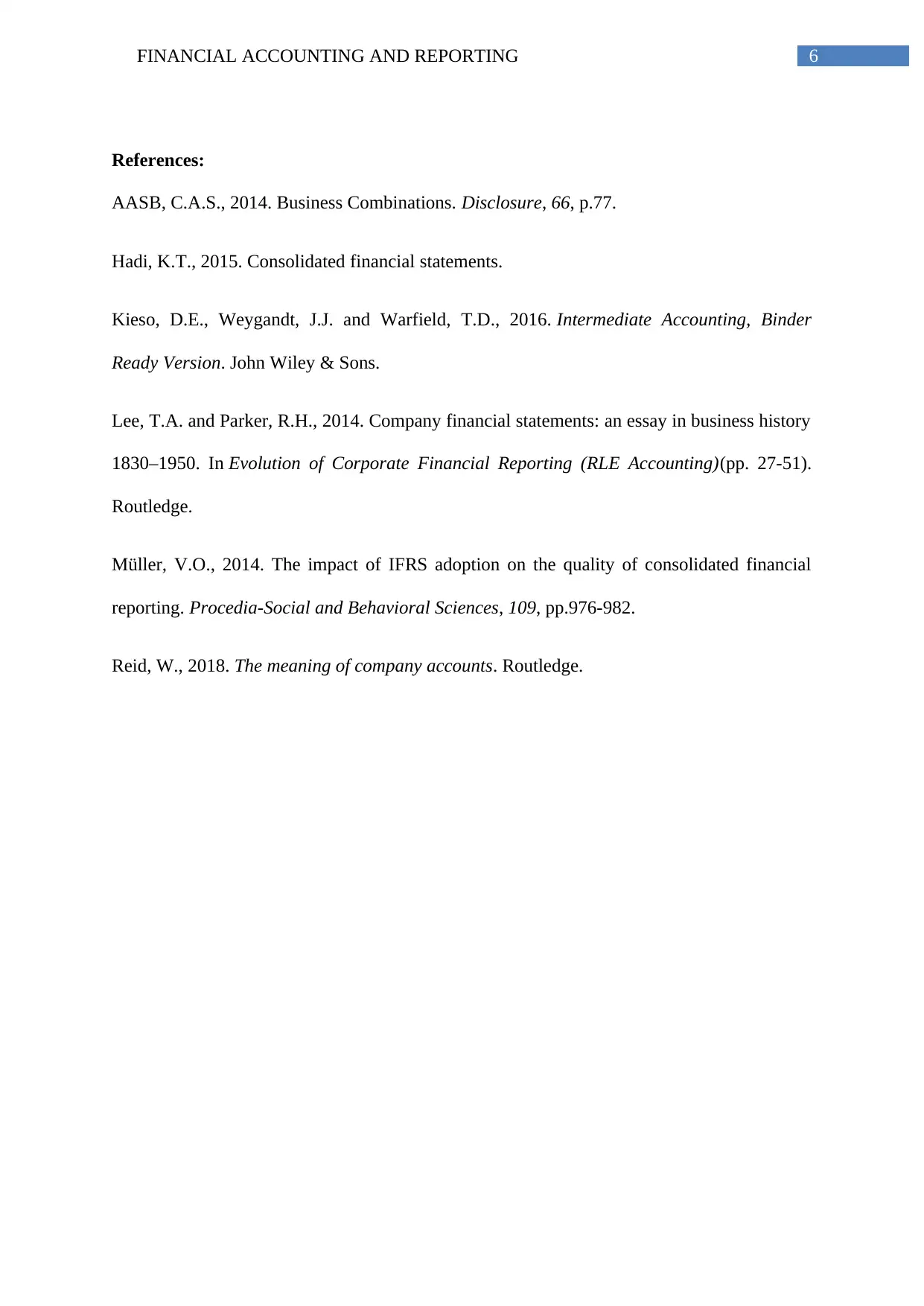
6FINANCIAL ACCOUNTING AND REPORTING
References:
AASB, C.A.S., 2014. Business Combinations. Disclosure, 66, p.77.
Hadi, K.T., 2015. Consolidated financial statements.
Kieso, D.E., Weygandt, J.J. and Warfield, T.D., 2016. Intermediate Accounting, Binder
Ready Version. John Wiley & Sons.
Lee, T.A. and Parker, R.H., 2014. Company financial statements: an essay in business history
1830–1950. In Evolution of Corporate Financial Reporting (RLE Accounting)(pp. 27-51).
Routledge.
Müller, V.O., 2014. The impact of IFRS adoption on the quality of consolidated financial
reporting. Procedia-Social and Behavioral Sciences, 109, pp.976-982.
Reid, W., 2018. The meaning of company accounts. Routledge.
References:
AASB, C.A.S., 2014. Business Combinations. Disclosure, 66, p.77.
Hadi, K.T., 2015. Consolidated financial statements.
Kieso, D.E., Weygandt, J.J. and Warfield, T.D., 2016. Intermediate Accounting, Binder
Ready Version. John Wiley & Sons.
Lee, T.A. and Parker, R.H., 2014. Company financial statements: an essay in business history
1830–1950. In Evolution of Corporate Financial Reporting (RLE Accounting)(pp. 27-51).
Routledge.
Müller, V.O., 2014. The impact of IFRS adoption on the quality of consolidated financial
reporting. Procedia-Social and Behavioral Sciences, 109, pp.976-982.
Reid, W., 2018. The meaning of company accounts. Routledge.
You're viewing a preview
Unlock full access by subscribing today!
1 out of 6
Related Documents
Your All-in-One AI-Powered Toolkit for Academic Success.
+13062052269
info@desklib.com
Available 24*7 on WhatsApp / Email
![[object Object]](/_next/static/media/star-bottom.7253800d.svg)
Unlock your academic potential
© 2024 | Zucol Services PVT LTD | All rights reserved.





